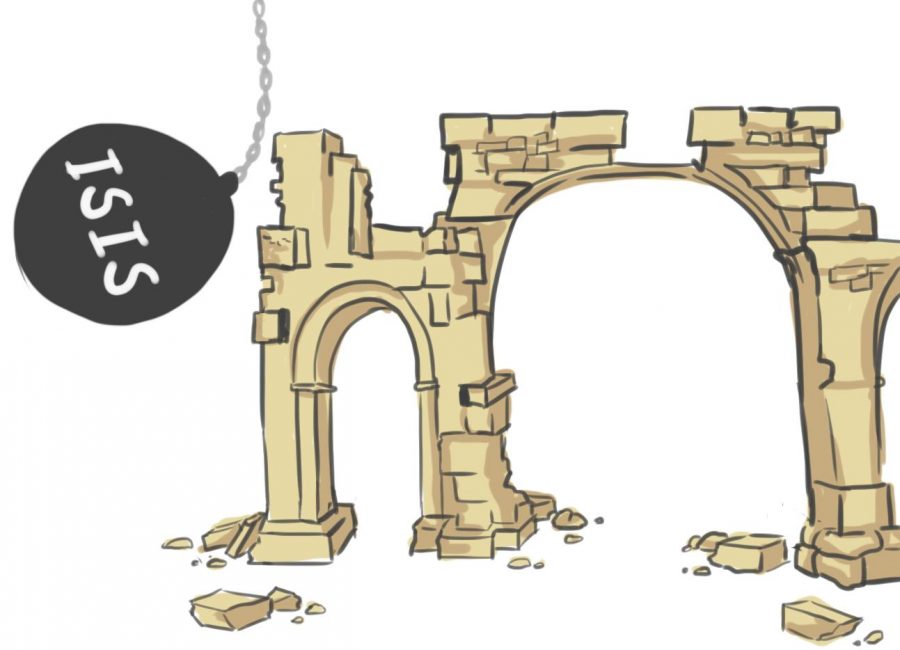Since the onset of conflict in Syria in 2011, ISIS has ravaged multiple archaeological sites in Syria — many of which have been relics for centuries and cherished in Syrian culture.
This past May, ISIS seized the Syrian town of Palmyra and the surrounding ancient ruins, initially promising not to destroy the site. Later, the militants conducted a public execution of Khaled al-Asaad, the principal archaeologist responsible for the site’s excavation, and released photographs of themselves rigging the Temple of Baalshamin — one of the site’s best-preserved remains — with explosives.
Many of the sites that ISIS has destroyed — including the tombs of Shiite saint Mohammad Bin Ali and Sufi scholar Nizar Abu Bahaa Eddine — are well-known relics among different sects of Islam. The Islamic State has used idol worship to justify its actions. ISIS has also used its looting of the sites to help pay for military expenses.
According to National Geographic reporter Andrew Curry, the group is said to take a cut from the sales of ancient artifacts looted by local populations, making tens of millions of dollars to fund its operations, particularly in Apamea — a Roman-era trading post that’s been heavily looted since the start of the Syrian Civil War.
The deliberate destruction of the ancient ruins threatens the sanctity of Syrian culture which, in the midst of a brutal civil war marked by fear and bloodshed, is all many Syrians have left. But the culture and solidarity Syrians share through the artifacts are antithetical to ISIS’ agenda of heralding an apocalypse, where genocide and universal demolition are the only goals. The universal community should meet Syrians in solidarity to further preserve the artifacts ISIS has targeted. In doing so, we are combatting the spread of ISIS by protecting elements of history they want eradicated from the face of the Earth.
The United Nations issued a statement in March saying, “All layers of Syrian culture are now under attack — including pre-Christian, Christian and Islamic.” Syrians of all religious backgrounds are seeing ISIS obliterate artifacts that had stood for centuries — some sites so ancient and significant they have world heritage status by the United Nations Educational, Scientific and Cultural Organization.
In the midst of the violence, fearmongering and pure shock value, one might say lives matter more than archaeology. But these sites act as foundations for Syrian history and serve as tribute to the nation’s culture and ritual. With the outright destruction of the homes, schools and workplaces, Syrians only have their culture to cling to — something they hold to a very high regard. But, because of ISIS, Syrians are quickly losing the physical presence of the symbols of nationality that connect them in spite of religious and political differences.
Syrian culture, history and nation help form part of its identity— an identity ISIS has tried to alter. It’s important for us, as an entire population, to value safeguarding these sites as an agency for bringing people together and as an agency to stop the spread of a group as monolithic as ISIS.
The destruction of Syrian historical sites shouldn’t be a partisan issue, either.
Sites ranging from Our Lady of Saidnaya Monastery — which is one of the most ancient monasteries in the world — to the Great Mosque of Aleppo — the largest and oldest mosque in Aleppo, Syria — are historical sites important to all Syrians. Regardless of religion, the demolition of these sites deprives Syrians and the international community of religeous venues to gather for prayer or weddings, for example.
In the future, these archaeological sites will serve as means for people to reconnect with Syria, a country so historically rich that its capital, Damascus, is one of the oldest inhabited cities in the world. With the spread of ISIS and its growth in strength, the Middle East could be completely remodeled into a caliphate to fit its ideal vision for the world — a replica of the Middle Ages. To do this, ISIS directly battles with history to reinstate barbarism, using bombs as erasers to eradicate anything suggesting progress.
Destroying Syria’s cultural heritage damages this potential for kinship and affiliation. We must realize the significance of these historical sites to the Syrian people and those around the world who value the maintenance of our ancestors’ legacies.
In doing so, we can mobilize to halt ISIS’s destruction of the sites and, as a result, help to cripple ISIS’ spread of its anachronistic agenda set to regress the world back to the sixth century.
By prioritizing the preservation of Syrian artifacts, we can combat the calamity ISIS has caused. And, most importantly, we can also reach solidarity across the globe with the people in Syria, which could be the most powerful vehicle to preservng the sites the Syrian people cherish.
Write to Jamie at [email protected]



